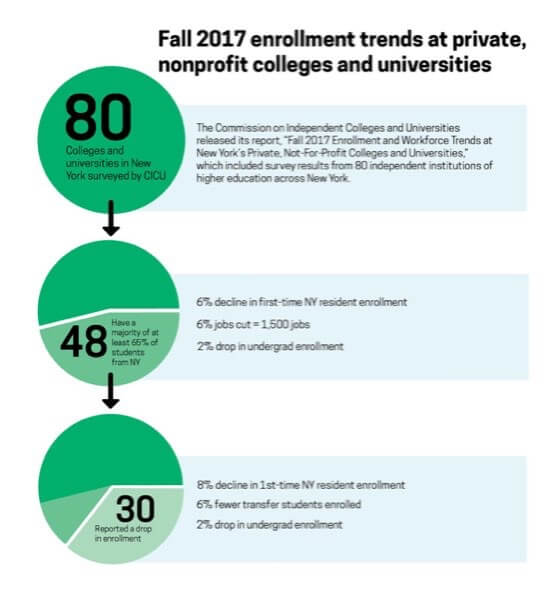By Annabelle Blair
The Commission on Independent Colleges and Universities reported that 30 private colleges and universities in New York have experienced a drop in enrollment rates this fall, the first semester that qualifying students at New York’s city and state colleges received free tuition under the Excelsior Scholarhip program.
Exelsior Scholarships cover the full cost of tuition for for students who are residents of New York, attending public and state colleges and living in households with yearly incomes of less than $100,000. The program was rolled out this fall as the first step in a three-phase plan to expand through 2019.
On Nov. 14, the CICU released the report, “Fall 2017 Enrollment and Workforce Trends at New York’s Private, Not-For-Profit Colleges and Universities,” which included survey results from 80 independent institutions of higher education across New York. The report tracked a decline in enrollment rates between fall 2016 and fall 2017. This follows Gov. Andrew Cuomo’s announcement of the Excelsior Scholarhips in January and state Legislature approval in April.
The drop in enrollment supported the CICU’s forecast in March that private colleges with students primarily from New York would see a strong decline in new students.
On Oct. 1, the governor’s office announced that about 53 percent of full-time students in the state’s public institutions were attending school tuition-free due to Excelsior scholarships and other government aid. The goal of the free-tuition scholarships is to make education accessible to students in the lower and lower-middle classes.
“Our first-in-the-nation Excelsior Scholarship is designed so more New Yorkers go to college tuition-free and receive the education they deserve to reach their full potential,” Cuomo said Oct. 1.
Although the CICU’s report does not directly mention Excelsior Scholarships, it documents negative enrollment and financial trends in private institutions after the scholarships went into effect. Of the 80 private, nonprofit institutions surveyed by the CICU, 48 have a 65 percent majority of residents from New York who are enrolled in undergraduate studies. These 48 institutions lost 6 percent of their workforce in the 2016-17 academic year, amounting to 1,535 jobs. The CICU report estimates 1,700 more jobs have been lost statewide as an indirect result of the work force reductions at private colleges and universities.
As a solution for private colleges and universities, lawmakers also included $19 million in the state’s budget for Enhanced Tuition Awards for the 2017-18 school year. This amount was significantly less than the $86 million chunk of the state’s budget set aside for Excelsior Scholarships. Through the ETA program, which includes Tuition Assistance Program aid and a matching grant from private colleges, students can access up to $6,000 in financial aid. New York undergraduates in households earning less than $100,000 annually are eligible for the ETA program.
Both Excelsior Scholarships and aid offered by the ETA program come with stipulations: Recipients must remain in New York after graduation for the same number of years they received the scholarships. If not, the awards default into loans.
Excelsior Scholarships have allowed over 2,000 students at public colleges and universities in Queens to receive full and partial tuition scholarships, according to Elizabeth Bibi, the deputy director of media relations at the governor’s office. The state aid is applauded by SUNY and CUNY school leadership.
“We look forward to growing this innovative program and bringing even more students to SUNY tuition-free as eligibility increases over the next two years,” Kristina Johnson, chancellor of SUNY, said last month.
Vaughn College of Aeronautics and Technology, located in Elmhurst, participated in the survey and is one of the 48 schools with a New-York majority undergraduate population. The college experienced a 2.4 percent drop in enrollment from fall 2016 to fall 2017, according to Sharon DeVivo, Vaughn’s president.
Applications for the ETA program opened in June and closed in late August, but students already three months into their school year at Vaughn’s have not received their ETA awards.
“We have roughly 70 students who applied but still have not received any notification from HESC (New York’s Higher Education Services Corporation) about who actually received the award,” DeVivo said.
She said Vaughn felt the drop in enrollment most deeply in its associate of applied science degree programs and in the decrease in students transferring into its Bachelor of Science degree programs.
St. John’s University in Jamaica, the second largest Catholic university in the country, has seen an approximate 4 percent decline in freshman enrollment from fall 2016 to fall 2017.
“We communicated and met all the program deadlines for ETA to our students, and now we’re waiting on New York state to process the applications,” Jennifer Tucholski, a member of the university’s Marketing and Communications department, said.
As a member of the CICU, St. John’s also participated in the survey as one of the 48 universities with a majority New-York-resident student body. Tucholski said transfer student rates have remained static since the Excelsior Scholarship and ETA programs took effect.
































